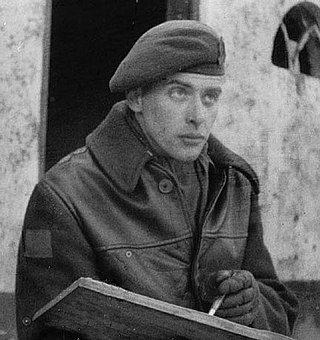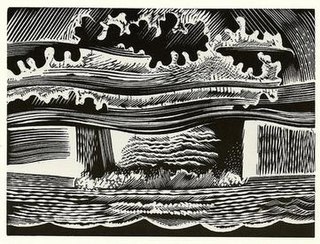
Cornelius David Krieghoff was a Dutch-born Canadian-American painter of the 19th century. He is best known for his paintings of Canadian genre scenes involving landscapes and outdoor life, which were as sought after in his own time as they are today. He painted many winter scenes, some in several variants.

David Alexander Colville, LL. D. was a Canadian painter and printmaker.

Lynd Kendall Ward was an American artist and novelist, known for his series of wordless novels using wood engraving, and his illustrations for juvenile and adult books. His wordless novels have influenced the development of the graphic novel. Although strongly associated with his wood engravings, he also worked in watercolor, oil, brush and ink, lithography and mezzotint. Ward was a son of Methodist minister, political organizer and radical social activist Harry F. Ward, the first chairman of the American Civil Liberties Union on its founding in 1920.
Jack Leonard Shadbolt, was a Canadian painter.
Derek Michael Besant is a Canadian artist living in Calgary, Alberta who, since the 1980s, has created prints, watercolours and large-scale art, shown in exhibitions and as public art projects in Canada and abroad. Since the mid-1990s, he has developed working with the new technology available in photographic imaging to create experimental prints and print installations.
Alma Mary Duncan was a Canadian painter, graphic artist, and filmmaker from Paris, Ontario. A prolific artist working in a variety of mediums including charcoal, chalk pastel, ink, watercolour, oil paint, puppetry, and film, Duncan's style evolved drastically over the course of her career to include portraiture, precise representational drawings, machine aesthetic, and abstraction.

Helen Barbara Howard was a Canadian painter, wood-engraver, drafter, bookbinder and designer who produced work consistently throughout her life, from her graduation in 1951 from the Ontario College of Art until her unexpected death in 2002.

Margaret Dorothy Shelton (1915–1984) was a Canadian artist who lived nearly all of her life in Alberta. She worked in a number of mediums but is best known for her block printing.
Rosemary Kilbourn is a Canadian printmaker, illustrator and stained glass artist known for her work in the wood engraving.

The wordless novel is a narrative genre that uses sequences of captionless pictures to tell a story. As artists have often made such books using woodcut and other relief printing techniques, the terms woodcut novel or novel in woodcuts are also used. The genre flourished primarily in the 1920s and 1930s and was most popular in Germany.

Southern Cross is the sole wordless novel by Canadian artist Laurence Hyde (1914–1987). Published in 1951, its 118 wood-engraved images narrate the impact of atomic testing on Pacific islanders. Hyde made the book to express his anger at the US military's nuclear tests in the Bikini Atoll.

George Alexander Walker is a Canadian artist and writer best known for his wood engravings and wordless novels.

Prelude to a Million Years: A Book of Wood Engravings is a 1933 wordless novel consisting of thirty wood engravings by American artist Lynd Ward (1905–1985). It was the fourth of Ward's six wordless novels, a genre Ward discovered while studying wood engraving in Europe, and delved into under the influence of the works of Frans Masereel and Otto Nückel. The symbol-rich story tells of a sculptor who, in his quest for ideal beauty, neglects the reality of the struggles of his neighbors in the depths of the Great Depression. The engravings are done in a softer Art Deco style in contrast to the German Expressionism-influenced artwork of Ward's earlier works.
Aganetha Dyck is a Canadian sculptor residing in Winnipeg, Manitoba. Dyck is best known for her work with live honeybees, that build honeycomb on objects that she introduces to honeybee hives. In 2007 Dyck was awarded both Manitoba's Arts Award of Distinction and Canada's Governor General's Award in Visual and Media Arts.
Renée Van Halm is a Canadian contemporary visual artist born in Haarlemmermeer, the Netherlands (1949) and immigrated to Canada in 1953.

Mary Annora Brown L.L. D. (1899–1987), known as Annora Brown, was a Canadian visual artist whose work encompassed painting and graphic design. She was best known for her depictions of natural landscapes, wildflowers, and First Nations communities in Canada. Much of her work thematically explored Albertan identity, though she remained relatively obscure in discussions of Canadian art.

Ulayu Pingwartok was a Canadian Inuk artist known for drawings of domestic scenes and nature.
David Bairstow (1921-1985) was a Canadian producer and director and one of the most prolific filmmakers at the National Film Board of Canada.
Henri Léopold Masson L.L. D. was a Canadian painter, known for his depictions of scenes in the province of Quebec.
William Walker Alexander, who signed his work W. W. Alexander, was a printmaker and bookplate maker.











